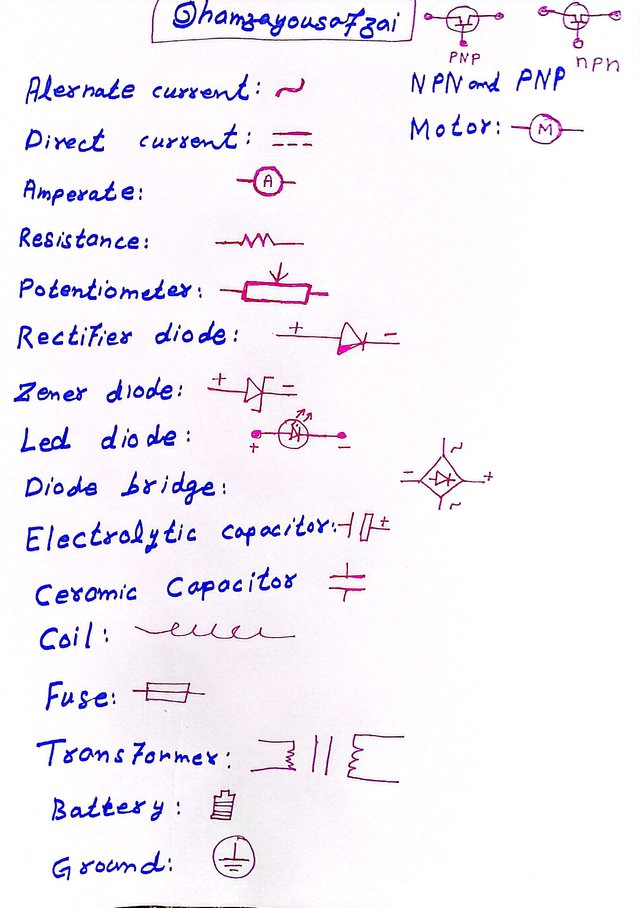Hello everyone and welcome aboard our electronics journey! Today marks the beginning of an exciting exploration into the fundamental aspects of electronic understanding components and their symbolic representations. This foundational knowledge is not just crucial it form the very heart of our learning path ahead. By mastering these essentials you will soon be adept at identifying electronic components sketching their symbols flawlessly and deciphering intricate circuit diagrams effortlessly. Join me as we embark on this enlightening quest together
In our first workshop session we delved into the essential world of electronic symbols. Here are the symbols I drew on paper for each component:

In Workshop 2 we explored the core definitions of key electronic components and terms essential to mastering electronics:
Alternating Voltage: Imagine a type of electricity that switche direction Periodically like the back and-forth motion of a swing. Its what we find in our homes from power outlets.
Direct Voltage: This is like a steady flow of water in one direction. Its the type of electricity you get from batteries in your remote control or flashlight.
- Resistance:
When electricity flows through a material like a wire or a component resistance is what slows it down. Its like how a narrow path might slow down people walking through it.
Potentiometer: Think of it like a volume knob on a radio. It's a knob you can turn to adjust how much electricity flows through a circuit.
Rectifier Diode: This component acts like a one-way valve for electricity. It allows electricity to flow in one direction Only which is useful when converting AC electricity from the wall into DC electricity for electronics.
Diode Bridge:
It's made up of four diodes working together. It helps to convert AC electricity into smoother DC electricity that Our devices can use more efficiently.
- Capacitor:
This is like a small battery that can charge and discharge very quickly. Its used to store and release Electricity helping to smooth out any bumps in the electricity flow.
- Transistor:
Imagine tiny switch that can turn a larger flow of electricity on or off. Its crucial for controlling the flow of electricity in electronic devices like computers and TVs.
- Transformer: Its like a magic box that can change the voltage of electricity. It uses coils of wire to increase r decrease the voltage to match what our devices need.
- Fuse:
This is a safety guard for your electronics. Its like tiny wire that melts if there too much electricity flowing through it cutting off the power and protecting your devices from damage.
- Lithium Battery: These are the modern superheroes of batteries. They pack lot of power in small size and last long time. You find them in phones laptops and electric car.
In this workshop i will delve into variou type of electronic components. understanding the different types of resistors capacitors diodes transistors according to their encapsulation and coils crucial for Mastering electronics.
.png)
1. Resistors:
Resistors are components that limit the flow of electric current in circuit. Here are some common type
- Carbon Composition Resistors: Made from mixture of carbon powder and binding material they are known for their reliability low cost.
- Metal Film Resistors: These have thin layer of metal their resistve element offering better precision and stability than carbon resistors.
- Wirewound Resistors: Constructed by winding metal wire around core these are used in applications requiring high power and precision.
- Surface Mount Resistors (SMD): Tiny resistors mounte directly onto the surface of printed circuit board (PCB) commonly use in modern electronic device.
2. Capacitors:
Capacitors store and release electrical energy. They come in various type based on their dielectric material
- Ceramic Capacitors: Made of ceramic material they are widely used due to their small size and stablity.
- Electrolytic Capacitors: These have larger capacitance per unit Volume and are polarized meaning they have a positive and negative lead.
- Tantalum Capacitors: Known for their stability and reliability these are Also polarized and offer high capacitance in a small size.
- Film Capacitors: Utilize thin plastic film the dielectric providing excellent performance in high-frequency applications.
3. Diodes:
Diodes allow current to flow in only one direction. here are some Common types
- Rectifier Diodes: Used to convert AC to DC they are essential in power supply circuit.
- Zener Diodes: Allow currents to flow in the reverse direction when specific voltage is reached commonly used for voltage regulation.
- LEDs (Light Emitting Diodes): emit light when current flow through them used in indicators and displays.
- Schottky Diodes: Known for Their low forward voltage drop and fast switching ideal for high-speed applications.
4. Transistors according to their encapsulation:
Transistors are used for switching and amplification. their encapsulation types include:
- TO-92 (small plastic package): Common for small signal transistors in low power applications.
- TO-220 (larger plastic package with metal tab): use for power transistors that require a heatsink.
- SOT-23 (small surface-mount package): Ideal for compact high-density circuit designs.
- DIP (Dual In-line Package): Often used in integrate circuits (ICs) with multiple transistors.
5. Coils (Inductors):
Coils or inductors store energy in magnetic field When current flow through them. Types include:
- Air Core Inductors: Simple inductors without magnetic core used in high frequency applications.
- Iron Core Inductors: Utilize an iron core to increase inductance commonly used in power supplies.
- Ferrite Core Inductors: Made with ferrite cores offering high inductance & low losses at high frequencies.
- Surface Mount Inductors: Compact inductor designed for mounting directly onto PCBs used in modern electronics.
.png)
.jpg)






Upvoted. Thank You for sending some of your rewards to @null. It will make Steem stronger.
Downvoting a post can decrease pending rewards and make it less visible. Common reasons:
Submit
Downvoting a post can decrease pending rewards and make it less visible. Common reasons:
Submit